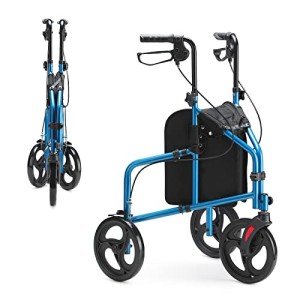walking-frame0571
walking-frame0571
5 Killer Quora Answers On Adjustable Walker
Understanding Adjustable Walkers: A Comprehensive Guide
Adjustable walkers are vital mobility aids created to supply stability and support to people with mobility challenges. They boost self-reliance, safety, and self-confidence for people recuperating from surgery, handling persistent conditions, or dealing with age-related mobility concerns. This post digs into the functions, types, benefits, and common FAQs associated with adjustable walkers, offering insights for prospective users and caregivers.
What is an Adjustable Walker?
An adjustable walker is a mobility aid that typically includes a lightweight frame with 4 legs, equipped with handgrips for assistance. It can be adjusted to accommodate various heights, ensuring users achieve a comfy wrist position while supporting their weight. Adjustable walkers can be found in numerous designs, each tailored to specific needs.
Secret Features of Adjustable Walkers
- Height Adjustment: Most adjustable walkers have telescoping legs, enabling users to easily modify the height to suit their stature.
- Weight Capacity: Different designs accommodate varying weight limits, accommodating a broad group.
- Foldability: Many walkers are collapsible, making them simple to shop and transportation.
- Wheels vs. No Wheels: Some walkers come with wheels on the front legs, while others have a standard design without wheels, promoting stability.
- Additional Accessories: Walkers can frequently be geared up with trays, baskets, or cup holders for included benefit.
| Feature | Description |
|---|---|
| Height Adjustment | Telescoping legs for personalized height settings |
| Weight Capacity | Varies by design, supporting different body weights |
| Foldability | Collapsible style for easy transportation and storage |
| Wheels | Available in both wheeled and non-wheeled options |
| Extra Accessories | Trays, baskets, and cup holders for user convenience |
Types of Adjustable Walkers
- Standard Walkers: Traditional models with 4 legs. Best for those looking for optimum stability.
- Wheeled Walkers (Rollators): Walkers with two or more wheels, enabling for much easier maneuvering.
- Hemi Walkers: Designed for people with using one hand, featuring a single arm assistance for added stability.
- Child Walkers: Specifically developed for infants finding out to walk, promoting safety and support throughout early mobility.
Benefits of Using Adjustable Walkers
Boost Independence
- Enhanced Mobility: Adjustable walkers enable users to navigate their environments with more ease and self-confidence, promoting a sense of self-reliance.
- Availability: With the right walker, users can preserve their way of life and take part in activities they delight in without support.
Injury Prevention
- Stability and Support: Walker users can maintain much better balance and avoid falls, which are particularly essential for seniors and individuals recovering from surgical treatment.
- Lowered Strain: Proper use of a walker can relieve tension on joints and muscles, decreasing the threat of injury throughout mobility.
Convenience and Customization
- Adjustable Settings: Walkers can be tailored to each user’s height and comfort, using a more customized experience.
- Extra Features: Options for devices assist in accommodating personal needs, enabling users to bring items while moving.
Expenses and Considerations
The cost of adjustable walkers ranges depending on features, materials, and brand name. Here’s a summary of the typical expenses connected with different types:
| Walker Type | Typical Cost |
|---|---|
| Standard Walkers | ₤ 50 – ₤ 100 |
| Wheeled Walkers | ₤ 75 – ₤ 200 |
| Hemi Walkers | ₤ 60 – ₤ 150 |
| Infant Walkers | ₤ 30 – ₤ 70 |
Regularly Asked Questions (FAQs)
1. How do I understand which adjustable walker is best for me?
The best adjustable walker depends upon your specific needs, physical condition, and environment. It’s vital to speak with a health care professional to figure out the most appropriate type.

2. Can I change the height of any walker?
Most adjustable walkers include a height-adjustment system. However, not all walkers are adjustable. It’s vital to analyze item requirements before purchasing.

3. Are wheeled walkers safe to use?
Yes, wheeled walkers (or rollators) are safe for users who can navigate them appropriately. They often consist of brakes for included safety when fixed.
4. How do I care for my adjustable walker?
Routine care involves cleaning the walker with moderate soap and water, looking for wear on grips and wheels, and making sure systems run efficiently.
5. Can I take my adjustable walker on public transportation?
Yes, lots of adjustable walkers are foldable and developed for simple transportation. However, it’s recommended to check the specific standards of the transportation service.
6. Do I need support to use an adjustable walker?
Lots of users can operate adjustable walkers independently, especially when effectively fitted to their height. Nevertheless, those with serious mobility issues might gain from help.
Adjustable walkers are important tools for enhancing mobility, self-reliance, and safety. With a range of design and styles, people can find a walker tailored to their requirements. Caregivers and users alike must appreciate the significance of speaking with healthcare specialists to make educated choices regarding mobility aids. Understanding the functions, benefits, and considerations of adjustable walkers empowers people to preserve an active lifestyle, enhancing their lifestyle regardless of mobility difficulties.


